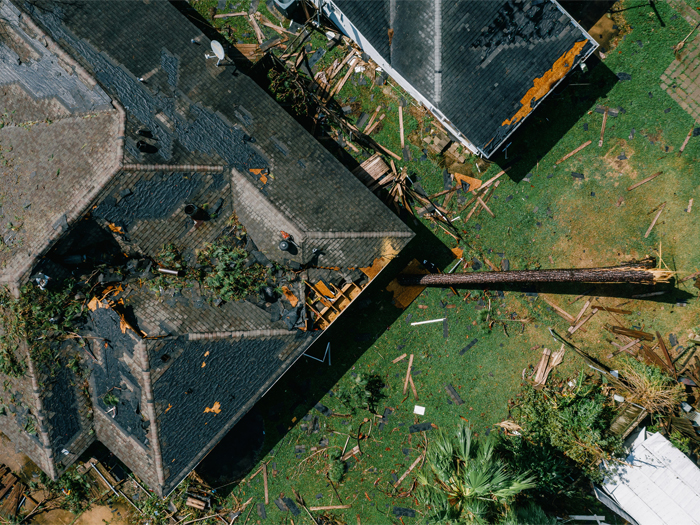Building Resilience Against Growing Hurricane Risks Will Require a Multi-Pronged Approach

With Hurricane Ian’s recent assault on Florida and two years of record-breaking hurricane seasons behind us, it’s no wonder insureds in coastal areas are questioning whether they’re prepared for a storm to hit.
Even businesses away from the coast may be seeking to increase their preparedness if they have a supplier that’s vulnerable to natural catastrophes (Nat CATs).
“There’s such a wide variety of losses and disruption stemming from both the initial physical damage and the longer-term wide area disruption that can sometimes last years,” said Cole Mayer, senior structurer at Swiss Re Corporate Solutions.
Emergency planning and risk management can go a long way, but insurance is also adapting to make sure businesses have adequate coverage. Improved data and modeling have led to improved parametric insurance products, allowing for a broader swath of coverages.
Together, shoring up a building’s defenses against intense storms, having an emergency plan in place and using smart financial risk transfer solutions can help insureds create a three-legged defense against growing hurricane exposures.
Building Resilience Through Mitigation and Smart Planning
Businesses can take a number of actions to mitigate the level of hurricane risk they face. Ensuring critical systems can keep running, even if a power outage occurs, can significantly reduce business interruption. On the public sector side, it can help to make sure critical pieces of infrastructure are able to withstand a storm.
“Our critical infrastructure is extraordinarily vulnerable. We rely on a network of utility lines and utility poles that tend to be above ground. We saw, after Hurricane Ida, there were certain parts of Louisiana that went well over 100 days without power,” said Megan Linkin, senior parametric Nat CAT structurer with Swiss Re Corporate Solutions.

Cole Mayer, Senior Structurer, Swiss Re Corporate Solutions
Having an emergency response plan is key to mitigating damages when a storm occurs. Building evacuation plans, systems for securing the building and other disaster-preparedness efforts are crucial to ensure businesses can get back up and running as quickly as possible after a storm hits.
“Our clients who manage hurricane risk most successfully are those who are creative with how they identify their potential hurricane exposures,” Mayer said.
Emergency plans need to be adaptable to varying weather conditions. Hurricanes have been undergoing rapid intensification at an increasing rate in recent years. Over the two most recent Atlantic hurricane seasons, 16 out of 20 storms experienced rapid intensification, according to the Washington Post.
“They increase in intensity over a very short period of time,” Linkin said. “When you are preparing for a hurricane, you’re going to prepare differently when expecting a tropical storm or a minimal hurricane versus a major hurricane like Hurricane Ian, Hurricane Ida or Hurricane Laura.”
In these situations, it’s better to “hope for the best, but plan for the worst,” Linkin advised.
“Don’t expect a storm that is currently at a tropical storm intensity to remain that way if it’s moving through a favorable environment. You might have to be ready for a very strong hurricane to come on shore.”
Data and Analytics Provide Risk Transfer Solutions
Even if insureds are well-prepared for a storm, physical damage and financial disruption may still occur. Strong winds can damage buildings or cause business shutdown, leading to a loss of income. Both traditional and nonstandard insurance products can step in and provide financial relief in these circumstances.
In some cases, businesses may be looking for coverages that are difficult to find in the traditional insurance market. Traditional property insurance will likely cover any direct damage to the building from natural perils, but most business interruption (BI) policies require the insured to experience physical damage to recover BI losses. If an insured’s building doesn’t experience direct physical damage from a hurricane but the community is badly damaged, the business may still experience a loss of income that would not be covered.
Others may lose revenue due to supply chain disruption, or on the public sector side, governments may experience costs they hadn’t accounted for as they try to respond to the crisis and rebuild. All these risks are difficult to cover with traditional insurance products.
“There’s loss of local attraction, revenue disruption, loss of revenue because of critical infrastructure or supply chain disruptions, and then unanticipated costs on the public sector side,” Linkin said.
That’s where parametrics come in. Parametric policies will pay out a set portion of a predefined limit if an event occurs within a set radius of the policyholder’s property.
So, for instance, a policy could be structured to pay out 60% of the limit if a category 3 hurricane strikes in a particular area. These policies pay out quickly — one policyholder received funds just 10 days after Hurricane Ian made landfall in Florida — and since they’re not tied to a particular asset, insureds can use them to cover things like lost income as well as repairs.

Megan Linkin, Senior Parametric Nat CAT Structurer, Swiss Re Corporate Solutions
“They are straightforward, and they are very transparent. So there’s no subjectivity in any claim settlement,” Linkin said.
Improved data modeling systems have allowed carriers to bring more parametrics to the market with better accuracy. Swiss Re Corporate Solutions uses RMS HWind data in its standard hurricane offering, and also offers hail and earthquake solutions.
“Parametric natural catastrophe insurance is quickly becoming a critical component of any natural catastrophe risk management approach,” Mayer said.
“As the data surrounding these perils gets more and more granular, ultimately we can design better and more responsive covers for our clients.”
When combined with traditional insurance policies, parametric covers can help reduce the amount of uninsured losses a business may face after a Nat CAT.
“Our whole goal is to try to minimize the amount of uninsured risk,” Mayer said. “These events continue to show the need for more creative methods of risk transfer to help these regions recover from disruptive storms.” &











